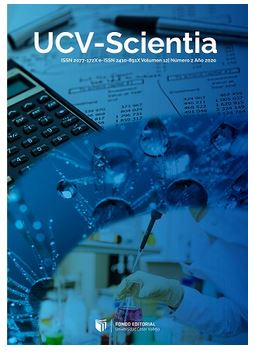The efficiency of process management in rural areas
DOI:
https://doi.org/10.18050/ucvs.v.13i1.03Keywords:
communication flow, Process management, EfficiencyAbstract
The purpose of this research was to verify the social progress and objectives achieved by the state in recent years, analyzing their impact on Andean communities and citizens living in rural areas, far from large cities, to determine the positive changes they have had and also the deficiencies in which they currently live. The data used in this document were obtained after a documentary analysis of the initiatives developed by the Peruvian government and opinion articles that allow us to learn more about the problems studied.
References
Aliaga Gustavo, D. M. (2008). Diagnostico de la Situacion de Salud en las Comunidades Alto Andinas del Departamento de Ancash. Revista Peruana de Epidemiología, 12(1), 1-7. Obtenido de https://www.redalyc.org/pdf/2031/203120337006.pdf
Canaza Choque, F. A. (2018). Educación y desigualdad en el Perú: Rupturas y redes de esperanza en el plan de vivir juntos. UCV Hacer- Revista de Investigación y Cultura, 7(2), 1-11. Obtenido de http://revistas.ucv.edu.pe/index.php/UCV-HACER/article/view/1669/1356
Gobierno del Perú. (2020). Implementación de la gestión por procesos en la administración pública. 1-31. Obtenido de https://sgp.pcm.gob.pe/wp-content/uploads/2020/11/IMPLEMENTACI%C3%93N-DE-LA-GESTI%C3%93N.pdf
Lasteros, Ñ. (2019). El impacto del nivel educativo alcanzando en el índice de calidad del empleo en Perú, 2016(11), 5-38. Obtenido de https://revistas.siep.org.pe/index.php/RPIE/article/view/91/190
López, N., & Sandoval, I. (2016). Métodos y técnicas de investigación cuantitativa y cualitativa. Obtenido de http://biblioteca.udgvirtual.udg.mx/jspui/bitstream/123456789/176/3/M%c3%a9todos%20y%20t%c3%a9cnicas%20de%20investigaci%c3%b3n%20cuantitativa%20y%20cualitativa.pdf
Martínez Vilar, C., Mosquera Fernández, A., & Monteagudo sánChez, B. (2015). Estudio observacional y descriptivo de prevalencia de onicomicosis en una población que acude a una consulta de dermatología del Área Sanitaria de Ferrol. Revista Internacional de Ciencias Podológicas, 9(2), 89-98. Obtenido de https://revistas.ucm.es/index.php/RICP/article/view/49019/45727
Mousalli-Kayat, G. (2015). Métodos y Diseños de Investigación Cuantitativa. Revista Researchgate. Obtenido de https://www.researchgate.net/profile/Gloria-Mousalli/publication/303895876_Metodos_y_Disenos_de_Investigacion_Cuantitativa/links/575b200a08ae414b8e4677f3/Metodos-y-Disenos-de-Investigacion-Cuantitativa.pdf
Palella Stracuzzi, S., & Martins Pestana, F. (2012). Metodología de la Investigación Cuantitativa (Tercera Edición ed.). Caracas, Venezuela: FEDUPEL. Obtenido de https://issuu.com/originaledy/docs/metodologc3ada-de-la-investigacic3b
Robles Guerrero, L., & Díaz Urteaga, P. (2017). Aplicando la gestión por procesos en el sector salud del Perú. Revista Academica Peru Salud, 24(1), 34-49. Obtenido de https://www.researchgate.net/profile/Luis-Robles-3/publication/338621355_APLICANDO_LA_GESTION_POR_PROCESOS_EN_EL_SECTOR_SALUD_DEL_PERU/links/5e1fd6c8a6fdcc10156c2f61/APLICANDO-LA-GESTION-POR-PROCESOS-EN-EL-SECTOR-SALUD-DEL-PERU.pdf
Sotelo Raffo, J. L. (2016). La gestión pro procesos en su papel de estrategia generadora de ventaja competitiva aplicada a los enfoques de asociatividad de las MyPES: Caso Peruano. Tesis doctoral. España: Universidad Politécnica de Catalunya BarcelonaTech. Obtenido de https://upcommons.upc.edu/bitstream/handle/2117/108505/TJLFSR1de1.pdf?sequence=1&isAllowed=y
Torres, D., & Ruiz Tagle, J. (2019). ¿Derecho a la vivienda o la propiedad privada? De la política pública a la informalidad urbana en el Área Metroplitana de LIma (1996-2015). EURE (Santiago), 45(136). Obtenido de https://www.scopus.com/record/display.uri?eid=2-s2.0-85073802376&origin=resultslist&sort=plf-f&src=s&sid=8d7cb4d1bfb1a0219a1178f1ec50eb3b&sot=b&sdt=b&sl=32&s=TITLE-ABS-KEY%28informali-dad+peru%29&relpos=3&citeCnt=1&searchTerm=
Vicuña Del Río, M. (2017). Impacto de la Densificación Residencial Intensiva en la Segmentación del Tejido Urbano de Santiago: Un Enfoque Cuantitativo. Revista 180(40), 78-93. Obtenido de http://www.revista180.cl/index.php/revista180/article/view/399/339
Downloads
Published
How to Cite
Issue
Section
License

This work is licensed under a Creative Commons Attribution-NonCommercial 4.0 International License.
- Share — copy and redistribute the material in any medium or format
- Adapt — remix, transform, and build upon the material.
- The licensor cannot revoke these freedoms as long as you follow the license terms.
Under the following terms:
-
Attribution — You must give appropriate credit, provide a link to the license, and indicate if changes were made. You may do so in any reasonable manner, but not in any way that suggests the licensor endorses you or your use.
- No additional restrictions — You may not apply legal terms or technological measures that legally restrict others from doing anything the license permits.













